April 2018 LIP of the Month
The Franklin Sills and Natkusiak Basalts of Victoria Island, Arctic Canada
Charles D. Bearda,c, Ben Hayesb, Nicole Williamson c, Jean Bédardd, Dominque Weisc, James S. Scoatesc, Peter Nabeleke
a British Geological Survey, The Lyell Centre, Edinburgh, UK
b School of Geosciences, University of Witwatersrand, Johannesburg, South Africa
c Pacific Centre for Isotopic and Geochemical Research, University of British Columbia, Vancouver, BC, Canada
d Geological Survey of Canada, Quebec office, Quebec City, QC, Canada
e Department of Geological Sciences, University of Missouri, Columbia, MO , USA
Email address (corresponding author): cbeard@bgs.ac.uk (Charles D. Beard)
Introduction
The Natkusiak continental flood basalts and Franklin sills of Victoria Island preserve an exceptional record of the ca. 716-723 Ma Franklin large igneous province (LIP) (Heaman et al., 1992), which extends over more than 1 million square km across northern Canada and into NW Greenland (Ernst & Bleeker 2010), and likely also extends into formerly adjacent southern Siberia (Ernst et al. 2016). The Franklin LIP is synchronous with major climatic variations (Macdonald et al., 2010; Macdonald & Wordsworth, 2017) and breakup of the supercontinent Rodinia (Li et al., 2008). A major field mapping campaign was conducted on Victoria Island during the summer months of 2010 and 2011. A component of the 'Geomapping for Energy and Minerals' initiative of the Geological Survey of Canada, this project was led by Jean Bédard and Rob Rainbird. As part of this work, twelve graduate students wrote theses on various aspects of the geology of Victoria Island. The text and figures below are extracted from and modified after publications associated with those studies pertinent to Franklin magmatism. A full list of references to this work follows the article text.
Photographs from the field seasons can be found here:
C. Beard: flic.kr/s/aHsjvDwZ5G
D. Weis: bit.ly/2q5fuXr
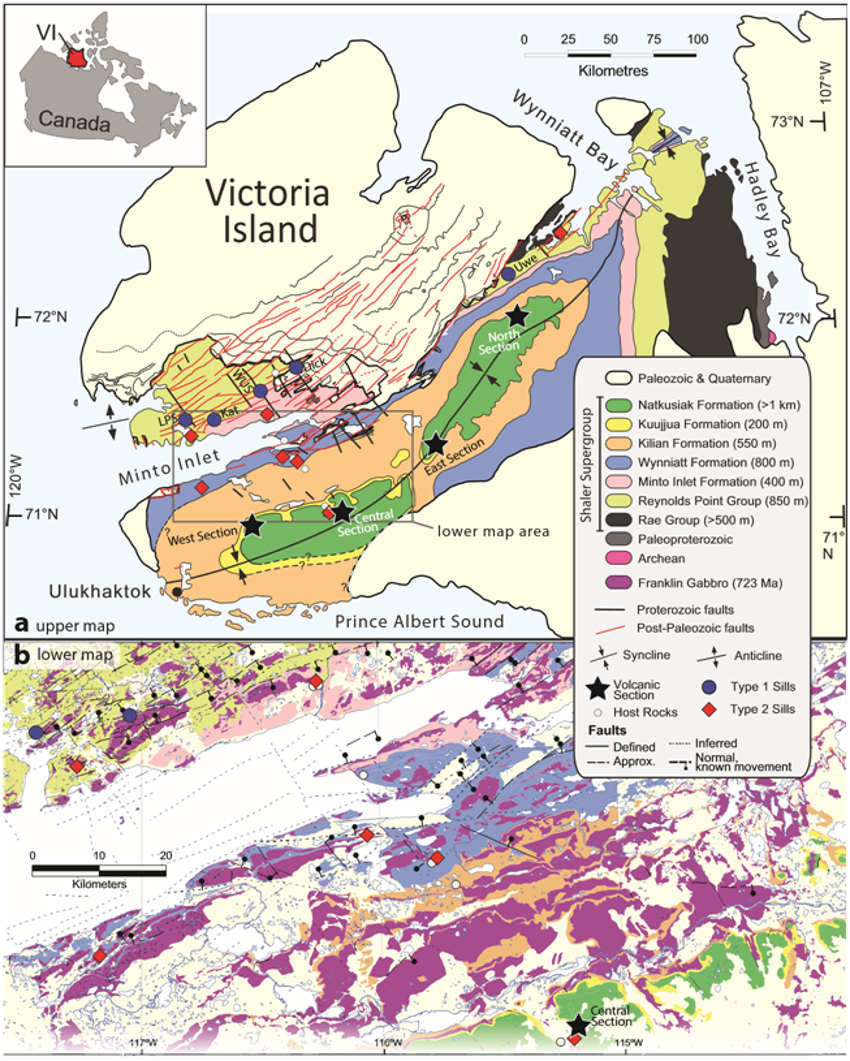
Figure 1: Geology of the Franklin large igneous province on Victoria Island, Arctic Canada. (a) Simplified geological map of the Neoproterozoic Minto Inlet in the northwestern portion of Victoria Island modified from Bédard et al. (2012), with regional location in northern Canada highlighted in the inset. (b) Detailed geological map in the area of the Minto Inlet, showing the lateral continuity of the Franklin sills (purple unit = Franklin Gabbro). Modified from Bédard et al. (2015) and other maps in the series.
The Natkusiak basalts
The Natkusiak Formation flood basalts are the only exposed extrusive rocks of the Franklin magmatic event and occur as two erosional lobes in the northern and southern parts of the Minto Inlier, Victoria Island. The volcanic stratigraphy and major element compositions of the basalts from both lobes are correlative, suggesting a similar petrogenetic history (Williamson et al., 2016). The onset of volcanism was concurrent with deposition of the underlying Kuujjua Formation and is marked by an early phase of discontinuous rubbly flows erupted into variably water-saturated topographic lows (<100m, low-Ti Type 1 magmas). During a subsequent hiatus in volcanism, two volcaniclastic units were emplaced over the Type 1 lavas via mass flow and by small, re-activated regional rivers. The onset of high-volume flood volcanism is preserved by an uppermost unit of thick, extensive tholeiitic sheet flows (∼1100m, high-Ti Type 2 magmas, Williamson et al. 2016). The striking documentation of eroded volcanic vents within the succession of the Type 2 lavas indicates that the formation of the Franklin LIP included transient episodes of fire-fountaining.
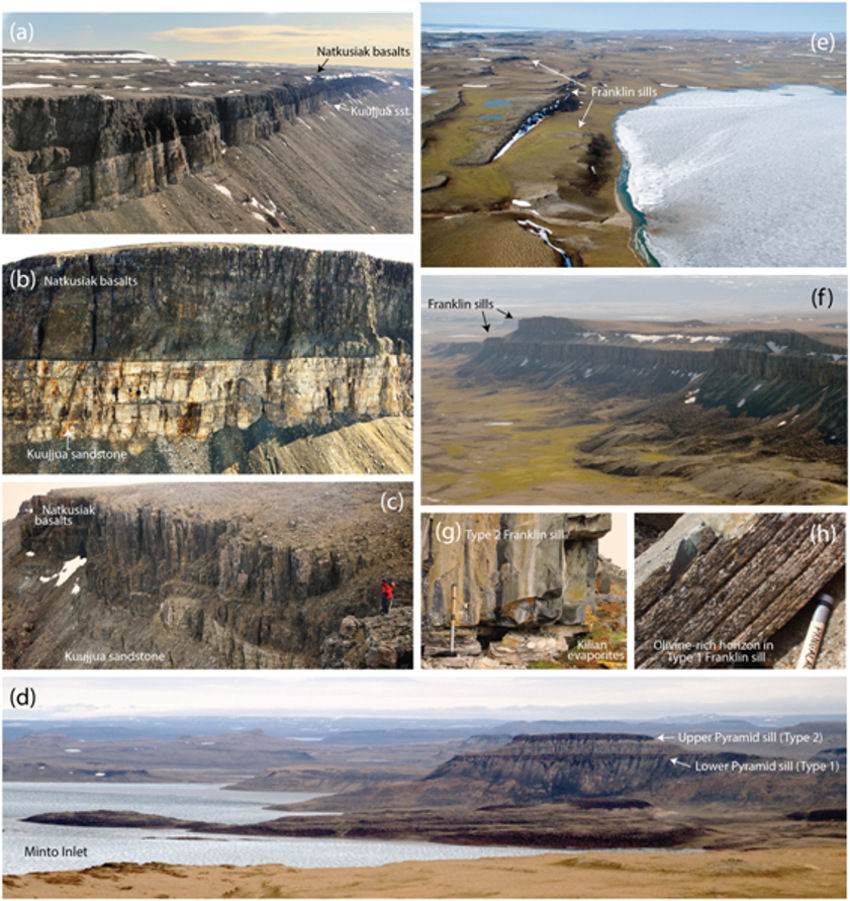
Figure 2: Photographs showing contact relations and internal structure of the Natkusiak basalts and Franklin sills on Victoria Island. (a,b) Cliff exposures of the laterally continuous contact between the Kuujjua sandstone (sst) and basal Natkusiak basalts on the south side of the Kuujjua River valley, with vertical section of cliff approximately 100 m in height. (c) Cliff exposure showing rare lobes of Kuujjua sandstone interbedded with the basal Natkusiak basalts, indicating that fluvial deposition continued after the initiation of volcanism (Rainbird, 1993) with vertical exposure approximately 70 m (d) The Pyramid sills (Hayes et al., 2015b,d). The Lower Pyramid sill is a 20 m thick Type 1 sill, and the top of the Upper Pyramid sill is approximately 250 m above sea level. (e,f) Cliff exposures of Type 2 Franklin sills on the southern shore of the Minto Inlet, each <15 m in height. (g) A typical basal contact of a Type 2 sill near the community of Ulukhaktok. The margin of the sill is chilled against the host Kilian Formation sulphate evaporites, which display only localised alteration (<10 cm). Hammer handle length is one meter. (h) An olivine-rich horizon from the base of the West Uhuk sill, displaying a characteristic elephant skin weathering texture. Hammer handle diameter is 4.5 cm.
Intrusive components of the Franklin LIP
The Franklin continental flood basalt province has a well exposed sill dominated intrusive system on Victoria Island. This intrusive system is coeval with the Natkusiak volcanic package and is hosted by sedimentary rocks of the carbonate and evaporite-dominated Shaler Supergroup. Franklin intrusions may be divided into differentiated low-Ti Type 1 and doleritic high-Ti Type 2, both of which show geochemical correlations with the northernmost basalts on Victoria Island.
Some sills are composite intrusions. Composite Type 1 sills are characterised by cyclic / macrorhythmic layering that is marked by olivine cumulate bases and overlying gabbroic dolerites. Detailed textural and mineral compositional data from the composite sills indicate that their olivine-rich bases formed when late picritic magmas intruded resident, crystallising gabbroic mushes (Hayes et al., 2015b,d). Similar composite intrusive behaviour is preserved in the Type 2 sills as internal chilled margins. Some Type 2 sills are glomero-porhyric, containing pyroxenitic and anorthositic microxenoliths that likely record mush development at depth (Hayes et al., 2015c). NNW trending fault structures were revealed by aeromagnetic surveys across the Minto Inlier (Kiss & Oneschuk, 2010). Field observations reveal that these are feeder dyke complexes that guided magma ascent to higher stratigraphic levels as sills and possibly fed the lavas (Bédard et al., 2012). These dykes are favourable locations for country rock-magma interaction because brecciation during fault-mediated melt ascent facilitated assimilation. Ingestion of sulphur-bearing country rocks adjacent to some of these dykes triggered incipient sulphide immiscibility (Hayes et al., 2015a). Contact aureoles in the calc-silicate wall rocks of most Franklin sills are limited relative to the dykes, the latter of which are only a few metres thick themselves. The highest metamorphic grades are characterized by grossular-andradite garnet, vesuvianite, and diopside (Nabelek et al., 2013). Computer simulations of coupled mineral reactions and fluid flow show that permeability of the wall rocks was very low, < 10−17 m2, which prevented efficient expulsion of generated CO2 out of the basin to the surface (Nabelek et al., 2014). The total contribution of metamorphic CO2 to the atmospheric budget from the aureoles was probably < 50 ppm, which in any case would probably have been consumed by weathering of Natkusiak basalts (e.g. Cox et al., 2016). δ34S measurements from the wall rocks adjacent to dykes indicate extensive hydrothermal mobilisation of volatile elements (Hryciuk, 2013). The intrusive components of the Franklin LIP record a dynamic magma plumbing system with cumulate crystal recycling, magma replenishment and crustal interaction.
The geochemistry of the Franklin LIP
Whole-rock Pb-Sr-Nd-Hf isotopic compositions from 66 samples of the Franklin sills and Natkusiak basalts (Beard et al., 2017) were used alongside a comprehensive database of whole-rock major-element and trace-element analyses (Bédard et al., 2016) to quantify the variety of mantle and lithospheric contributions to Franklin magmatism. Franklin rocks from Victoria Island may be divided into groups based on field relationships, their geochemistry, and their radiogenic isotope compositions: Type 1 low-Ti magmas are preserved as the basal Natkusiak basalts and Type-1 Franklin sills, whereas the younger, more voluminous Type 2 high-Ti magmas are observed in the Natkusiak sheet flow basalts and Type-2 Franklin sills. Both of these magma types may be divided into northern and southern geographic subgroups based on variations in trace element and radiogenic isotope ratios defining a total of four geochemical groups.
Northern Type 1 basalts have low initial (at 723 Ma) ε Nd (-6.1 to -0.8), εHf (-4.3 to +4.6), Nb/La (0.42 to 0.67) and high initial 87Sr/86Sr (0.7051 to 0.7075), suggesting the incorporation of continentally derived materials (see Discussion below). These basalts correspond geochemically to the Type 1 sills. The overlying Northern Type 2 sheet flow basalts (units V 1 and V2) have a similar geochemical affinity to the Type 2 sills, and have higher initial εNd (+1 to +8.8) and εHf (+4.7 to +15.8), suggesting a waning of continental contributions to magmatism with time. Their REE patterns steepen relative to the northern Type 1 rocks, suggesting a deepening of the mantle source.
By contrast Southern Type 1 basalts show negligible continental influence (Nb/La = 0.81 to 0.94) and have unusually high initial εNd ratios (+4.4 to +11.8) that are decoupled from initial εHf (+0.8 to +11.1). Directly overlying, the Southern Type-2 sheet flow basalts have similar trace element compositions to their northern counterparts, but retain the decoupled ε Nd - εHf signature of the southern Type 1 rocks, indicating involvement of a long-lived source component that had high time-integrated Sm/Nd and lacked correspondingly high Lu/Hf.
Modelling crustal contamination of Franklin magmas
Assimilation modelling was performed to provide constraints for SO 2 and CO2 emissions associated with the emplacement of the Franklin LIP, to explore links between this magmatism and the onset of the global-scale Sturtian glaciation, and to determine contributions from basement granitoids to Franklin magmatism that provide insight into the development of the magmatic architecture during progressive continental rifting (Beard et al., 2017).
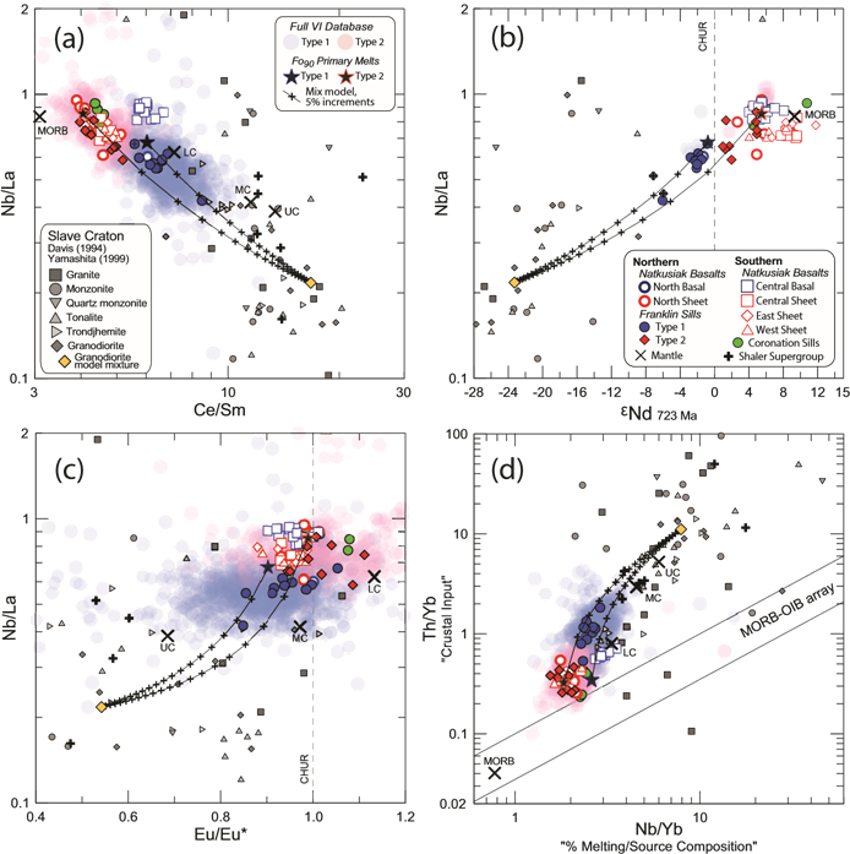
Figure 3: Trace element ratio and Nd isotope diagrams for whole-rocks of the Natkusiak basalts and Franklin sills on Victoria Island showing calculated bulk mixtures of Type 1 and Type 2 primary melts in equilibrium with Fo90 olivine and a mixture of Slave Province granitoids. Primary melt compositions are calculated back to Fo90 equilibrium compositions by incrementally adding equilibrium olivine (Turner & Langmuir, 2015). The curves are marked at 5% intervals (small crosses). For comparison, a variety of Slave Province granitoid country rocks that represent (Davis et al., 1994; Yamashita et al., 1999).
To model crustal contamination of Franklin magmas, we first corrected for residual enrichment of trace elements during fractionation of olivine, a mineral in which many geologically interesting trace elements are highly incompatible (calculations employ Diol/melt values derived following Bédard 2005). The derived model primary melt compositions were then mixed with a variety of potential crustal contaminations to identify potential magmatic contaminants and the extent to which they were assimilated. A variety of contaminant compositions were explored, including Shaler Supergroup sedimentary rocks that host the Franklin sills, and Archean granitoids of the Slave Province that constitute the basement for Victoria Island.
Modelling of assimilation of Shaler Supergroup sedimentary rocks gives non-unique solutions because of the broad diversity of Shaler carbonate and evaporite rocks and their low trace element contents. As a result, the emissions of both aerosols and greenhouse gases during Franklin magmatism remain poorly constrained (also see Nabelek et al. 2013, 2014). Similar models that employed Slave province basement rock compositions were much more successful. A broad range of local granitoid compositions was examined, and one was identified that could produce mixing trends through the entire data set, with similar extents of assimilation derived from multiple ratios of trace elements and radiogenic isotopes (Fig. 3)
The assimilation models indicate that Northern Type 1 rocks incorporated up to 10% granitoid basement, a relatively weak continental signature compared to many other continental flood basalt provinces. The overlying Type 2 northern sheet flow basalts and corresponding doleritic sills incorporated up to 5% granitoid, consistent with a waning continental influence during maturation of the magmatic system.
Throughout the province, neither radiogenic isotope ratios, nor trace element ratios used in assimilation models are correlated with indices of fractional crystallisation (e.g. melt CaO/Al2O3, SiO 2 or Zr content). This finding indicates that the continental material incorporated into Franklin magmas was either dispersed within the melt source, or that heterogeneous contamination occurred prior to differentiation.
Source components for the Franklin sills and Natkusiak basalts
The Northern Type 1 and Northern Type 2 basalts and sills show geochemical evidence for an aesthenosphere-dominated melt source with minor contributions from Slave Province granitoid rocks. In contrast, toward the south west of Victoria Island, the Southern Type 1 and Southern Type 2 rocks have high εNd compositions that are decoupled from εHf (Fig. 4). Such signatures are unusual, as nearly all terrestrial rocks plot within the narrow, positively correlated terrestrial array on an εNd - εHf diagram (Vervoort et al., 1999, 2000). Despite isotopic differences, the major element compositions and physical volcanology (Williamson et al., 2016) of the Southern Type 1 and Type 2 basalts are comparable with the Northern Type 1 and Type 2 basalts, suggesting a similar petrogenetic history. Geographic distinctions between the Northern and Southern rocks weaken with maturation of the magmatic plumbing system, although to not disappear.
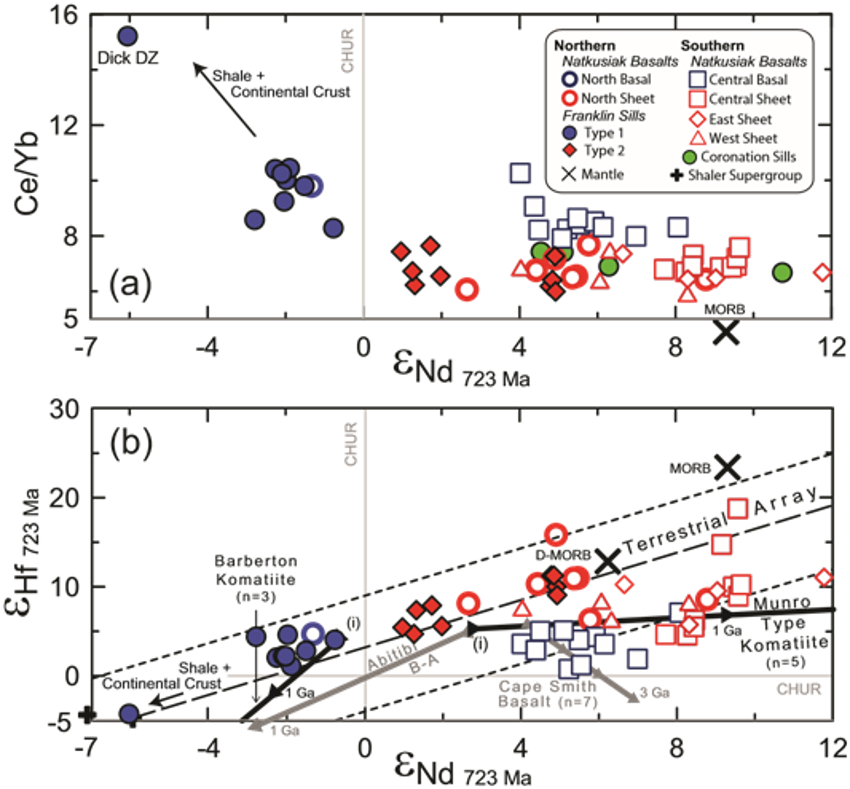
Figure 4: Ce/Yb, initial eNd and initial eHf diagrams for whole-rocks of Natkusiak basalts and Franklin sills on Victoria Island. Results for the coeval Coronation sills on the Canadian mainland (Shellnutt et al. , 2004) are plotted for comparison and have been re-corrected for age from the original reported results. Dick DZ is the diabasic roof zone of Dick?s Sill, a layered Type 1 intrusion. Depleted MORB (DM) and MORB compositions as defined in Fig. 8 of Beard et al., (2017). The terrestrial array (long-dashed line) in (b) is from Vervoort et al. (1999) and the short-dashed lines indicate the approximate range of oceanic basalts. Black and grey bold lines show the isotopic evolution of mafic Archean and Palaeoproterozoic rocks of suggested oceanic origin, with (i) as initial compositions, and marked ticks at 1 Ga incubation intervals (model after Nowell et al. 2004). The Munro-type komatiites are from the Abitibi and Belingwe belts (n = 5), the Barberton komatiites are from the Barberton belt (n = 3, both Blichert-Toft et al. 1999), the Abitibi basaltic andesite is indicated 'B-A', and the Cape Smith belt basalts (n = 7) are from the Chukotat Group (both Vervoort & Blichert-Toft 1999). The model suggests that the source of the Southern Natkusiak basalts may include an isotopically matured Munro-type komatiite component, and discounts major involvement of Abitibi-type basaltic andesite or Barberton-type komatiite.
Decoupling of the εNd and ε Hf isotopic systems can occur in a limited number of geological scenarios. In the case of the Franklin LIP, the source for the southern Natkusiak basalts had high time integrated Sm/Nd without correspondingly high Lu/Hf. A material with these characteristics is oceanic crust that has fractionated garnet, or that was extracted from a garnet-bearing mantle restite. As such, we modelled the isotopic maturation trajectories for several mafic to ultramafic Archean and early Proterozoic rocks of suggested oceanic origin (Fig. 4). Some compositions do indeed incubate suitable isotopic compositions in as little as 1 Ga and could represent major source components for the Southern Natkusiak basalts and related sills.
As the distinctive Nd-Hf isotopic signature of the Southern basalts is persistent throughout the entire preserved volcanic stratigraphy, the source of such signatures was likely in the asthenospheric mantle, rather than the lithosphere. A lithospheric source would be cold and refractory, hence unlikely to melt extensively. If the lithosphere were somehow able to melt, it would be likely be rapidly exhausted. In the asthenospheric hypothesis, two distinctive isotopic flavours were present in the Franklin plume, much like those that are documented in the Loa and Kea trend basalts preserved in the Hawaiian islands today (Weis et al., 2011; Harrison et al., 2017). Plume heterogeneity might reflect variable contributions from matured oceanic lithosphere, which were recycled into the asthenospheric mantle long (≥ 1 Ga) before the onset of Franklin magmatism.
Implications and summary
The geochemistry of the Franklin sills and Natkusiak basalts on Victoria Island allow for the comparison of the preserved feeder system and volcanic products of a large Neoproterozoic continental flood basalt province (Fig. 5). During initiation, lateral variations in source composition defined the geochemical characteristics of the magmas. Low-Ti basalts with a continental influence ascended through the crust and were emplaced as Type 1 Franklin sills and erupted as basal Natkusiak basalts in the north. Uncontaminated low-Ti basal basalts were emplaced only in the south. As the degree of melting in the plume head increased, flood basalt volcanism reached its zenith during high-Ti Type 2 magmatism. Emplacement of doleritic Type 2 sills remained limited to the northern source region, despite waning differences in source signatures between northern and southern magmas. As both the northern and southern volcanic rocks exhibit contrasting isotopic signatures throughout the preserved stratigraphy, the magma plumbing system must have experienced limited lateral mixing and homogenisation, which allowed for the expression of distinct mantle source signatures in the high-level sills and basaltic lavas. The persistence of Nd-isotopic heterogeneities throughout all stages of development of the Franklin large igneous province resulted from lateral compositional variations within the mantle plume, and likely reflects contributions from isotopically matured Archaean or Palaeoproterozoic oceanic lithosphere that was recycled deep into the asthenosphere.
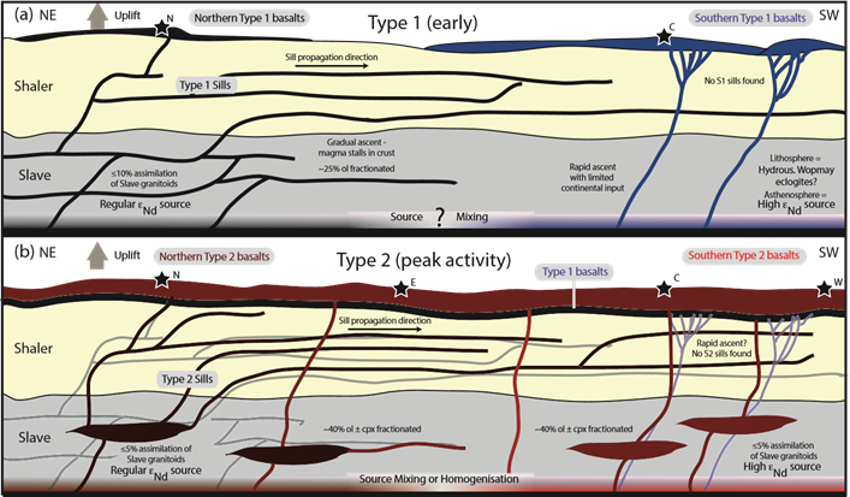
Figure 5: Schematic cross-sections showing the intrusion pathways and distribution of source components associated with Franklin magmatism on Victoria Island. Black stars indicate approximate locations of the Northern, Eastern, Central, and Western sections at which the Natkusiak basalts were sampled. Horizontal field of view is approximately 200 km.
Publications from this project
Beard, C., Scoates, J., Weis, D., Bédard, J, Dell'Oro, T. (2017). Geochemistry and origin of the Neoproterozoic Natkusiak Flood Basalts and related Franklin Sills, Victoria Island, Arctic Canada. Journal of Petrology 58:11, p2191-2220, doi: 10.1093/petrology/egy004.
Bédard, J.H., Hayes, B., Hryciuk, M., Beard, C., Williamson, N., DellOro, T.A., Rainbird, R.H., Prince, J., Baragar, W. R.A., Nabelek, P., Weis, D., Wing, B., Scoates, J.S., Naslund, H.R., Cousens, B., Williamson, M.-C., Hulbert, L., Montjoie, R., Girard, E., Ernst, R., & Lissenberg, C.J. (2016). Geochemical database for Victoria Island, Geological Survey of Canada Geomapping for Energy and Minerals project. Geological Survey of Canada, Open File 8009.
Bédard, J.H., Naslund, H.R., Nabelek, P., Winpenny, A., Hryciuk, M., Macdonald, W., Hayes, B., Steigerwaldt, K., Hadlari, T., Rainbird, R., Dewing, K., & Girard, E. (2012). Fault-mediated melt ascent in a Neoproterozoic´ continental flood basalt province, the Franklin sills, Victoria Island, Canada. Geological Society of America Bulletin, 124(5-6), 723-736.
Hayes, B., Bédard, J.H., Hryciuk, M., Wing, B., Nabelek, P., MacDonald, W.D., & Lissenberg, C.J. (2015a). Sulfide immiscibility induced by wall-rock assimilation in a fault-guided basaltic feeder system, Franklin Large Igneous Province, Victoria Island (Arctic Canada). Economic Geology, 110(7), 1697- 1717.
Hayes, B., Bédard, J.H., & Lissenberg, C.J. (2015b). Olivine slurry replenishment and the development of igneous layering in a Franklin Sill, Victoria Island, Arctic Canada. Journal of Petrology, 56(1), 83-112.
Hayes, B., Lissenberg, C.J., Bédard, J.H., & Beard, C. (2015d). The geochemical effects of olivine slurry replenishment and dolostone assimilation in the plumbing system of the Franklin Large Igneous Province, Victoria Island, Arctic Canada. Contributions to Mineralogy and Petrology, 169(2), 1-18.
Hryciuk, M. (2013). Host-rock Contamination and Sulfide Immiscibility in the Franklin Large Igneous Province, Victoria Island, Canada. MSc Thesis, McGill University, Montréal, Canada.
Nabelek, P.I., Bédard, J.H., Hryciuk, M., & Hayes, B. (2013). Shortduration contact metamorphism of calcareous sedimentary rocks by Neoproterozoic Franklin gabbro sills and dikes on Victoria Island, Canada. Journal of Metamorphic Geology, 31(2), 205-220.
Nabelek, P.I., Bédard, J.H., Rainbird, R.H. (2014). Numerical constraints on degassing of metamorphic CO2 during the Neoproterozoic Franklin large igneous event, Arctic Canada. GSA Bulletin, 126(5-6), 759-772.
Williamson, N. M.B., Ootes, L., Rainbird, R.H., Bédard, J.H., & Cousens, B. (2016). Initiation and early evolution of the Franklin magmatic event preserved in the 720 Ma Natkusiak Formation, Victoria Island, Canadian Arctic. Bulletin of Volcanology, 78(3), 1-19.
Click to open/close ReferencesFull list of references
Beard, C. D., Scoates, J. S., Weis, D., Bédard, J. H., & Dell'Oro, T. A. (2017). Geochemistry and Origin of the Neoproterozoic Natkusiak Flood Basalts and Related Franklin Sills, Victoria Island, Arctic Canada. Journal of Petrology, 58(11), 2191-2220.
Bédard, J. H. (2005). Partitioning coefficients between olivine and silicate melts. Lithos, 83(34), 394-419.
Bédard, J. H., Hayes, B., Hryciuk, M., Beard, C., Williamson, N., Dell'Oro, T. A., Rainbird, R. H., Prince, J., Baragar, W. R. A., Nabelek, P., Weis, D., Wing, B., Scoates, J. S., Naslund, H. R., Cousens, B., Williamson, M.-C., Hulbert, L., Montjoie, R., Girard, E., Ernst, R., & Lissenberg,´ C. J. (2016). Geochemcial database for Victoria Island, Geological Survey of Canada Geomapping for Energy and Minerals project. Tech. rep., Geological Survey of Canada.
Bédard, J. H., Naslund, H. R., Nabelek, P., Winpenny, A., Hryciuk, M.,Macdonald, W., Hayes, B., Steigerwaldt, K., Hadlari, T., Rainbird, R., Dewing, K., & Girard, E. (2012). Fault-mediated melt ascent in a Neoproterozoic continental flood basalt province, the Franklin sills, Victoria Island, Canada. Geological Society of America Bulletin, 124(5-6), 723-736.
Bédard, J. H., Rainbird, R. H., & Beard, C. (2015). Geology, Qulliq, Victoria Island, Northwest Territories.
Blichert-Toft, J., Albarède, F., Rosing, M., Frei, R., & Bridgwater, D. (1999). The Nd and Hf isotopic evolution of the mantle through the Archean. results from the Isua supracrustals, West Greenland, and from the Birimian terranes of West Africa. Geochimica et Cosmochimica Acta, 63(22), 3901- 3914.
Cox, G. M., Halverson, G. P., Stevenson, R. K., Vokaty, M., Poirier, A., Kunzmann, M., Li, Z.-X., Denyszyn, S. W., Strauss, J. V., & Macdonald, F. A. (2016). Continental flood basalt weathering as a trigger for Neoproterozoic Snowball Earth. Earth and Planetary Science Letters , 446, 89-99.
Davis, W. J., Fryers, B. J., & King, J. E. (1994). Geochemistry and evolution of late Archean plutonism and its significance to the tectonic development of the Slave craton. Precambrian Research, 67 (34), 207-241.
Ernst, R.E., & Bleeker, W. (2010). Large igneous provinces (LIPs), giant dyke swarms, and mantle plumes: significance for breakup events within Canada and adjacent regions from 2.5 Ga to present. Canadian Journal of Earth Sciences, 47, 695-739,
Ernst, R.E., Hamilton, M.A., Söderlund, U., Hanes, J.A., Gladkochub, D.P., Okrugin, A.V., Kolotilina, T., Mekhonoshin, A.S., Bleeker, W., LeCheminant, A.N., Buchan, K.L., Chamberlain, K.R., & Didenko, A.N. (2016). Long-lived connection between southern Siberia and northern Laurentia in the Proterozoic. Nature Geoscience, 9, 464-469,
Harrison, L. N., Weis, D., & Garcia, M. O. (2017). The link between Hawaiian mantle plume composition, magmatic flux, and deep mantle geodynamics. Earth and Planetary Science Letters, 463, 298-309.
Hayes, B., Bédard, J. H., Hryciuk, M., Wing, B., Nabelek, P., MacDonald, W. D., & Lissenberg, C. J. (2015a). Sulfide immiscibility induced by wallrock assimilation in a fault-guided basaltic feeder system, Franklin Large Igneous Province, Victoria Island (Arctic Canada). Economic Geology, 110(7), 1697-1717.
Hayes, B., Bédard, J. H., & Lissenberg, C. J. (2015b). Olivine slurry replenishment and the development of igneous layering in a Franklin Sill, Victoria Island, Arctic Canada. Journal of Petrology, 56(1), 83-112.
Hayes, B., Lissenberg, C. J., & Bedard, J. H. (2015c). Partners in crime: combined mush disaggregation and in-situ crystallization in a basaltic sill. In Goldschmidt Conference. Prague, CZ.
Hayes, B., Lissenberg, C. J., Bédard, J. H., & Beard, C. (2015d). The geochemical effects of olivine slurry replenishment and dolostone assimilation in the plumbing system of the Franklin Large Igneous Province, Victoria Island, Arctic Canada. Contributions to Mineralogy and Petrology, 169(2), 1-18.
Heaman, L. M. L., LeCheminant, A. A., Rainbird, R. H. R., Letters, P. S., Museum, R. O., Heaman, L. M. L., LeCheminant, A. A., & Rainbird, R. H. R. (1992). Nature and timing of Franklin igneous events, Canada: implications for a Late Proterozoic mantle plume and the break-up of Laurentia. Earth and Planetary Science ..., 109(4), 117-131.
Hryciuk, M. (2013). Host-rock Contamination and Sulfide Immiscibility in the Franklin Large Igneous Province, Victoria Island, Canada. MSc Thesis, McGill University Montréal, Canada.
Kiss, F. & Oneschuk, D. (2010). First vertical derivative of the magnetic field, Minto Inlier aeromagnetic survey, Victoria Island, NTS 87 G/SE and parts of 87 G/NW, 88B/SE and 88 B/SW, Northwest Territories. Geological Survey of Canada Open-File Map 6705, scale 1:100,000..
Li, Z. X., Bogdanova, S. V., Collins, A. S., Davidson, A., De Waele, B., Ernst, R. E., Fitzsimons, I. C. W., Fuck, R. A., Gladkochub, D. P., Jacobs, J., Karlstrom, K. E., Lu, S., Natapov, L. M., Pease, V., Pisarevsky, S. A., Thrane, K., & Vernikovsky, V. (2008). Assembly, configuration, and breakup history of Rodinia: A synthesis. Precambrian Research, 160(12), 179- 210.
Macdonald, F. A., Schmitz, M. D., Crowley, J. L., Roots, C. F., Jones, D. S., Maloof, A. C., Strauss, J. V., Cohen, P. A., Johnston, D. T., & Schrag, D. P. (2010). Calibrating the Cryogenian. Science, 327(5970), 1241-1243.
Macdonald, F. A. & Wordsworth, R. (2017). Initiation of Snowball Earth with volcanic sulfur aerosol emissions: Volcanic aerosols snowball initiation. Geophysical Research Letters, 44, 1938-1949.
Nabelek, P. I., Bédard, J. H., Hryciuk, M., & Hayes, B. (2013). Shortduration contact metamorphism of calcareous sedimentary rocks by Neoproterozoic Franklin gabbro sills and dikes on Victoria Island, Canada. Journal of Metamorphic Geology, 31(2), 205-220.
Nabelek, P. I., Bédard, J. H., & Rainbird, R. H. (2014). Numerical constraints on degassing of metamorphic CO2 during the Neoproterozoic Franklin large igneous event, Arctic Canada. GSA Bulletin, 126(5-6), 759-772.
Nowell, G. M., Pearson, D. G., Bell, D. R., Carlson, R. W., Smith, C. B., Kempton, P. D., & Noble, S. R. (2004). Hf isotope systematics of kimberlites and their megacrysts: New constraints on their source regions. Journal of Petrology, 45(8), 1583-1612.
Rainbird, R. H. (1993). The sedimentary record of mantle plume uplift preceding eruption of the Neoproterozoic Natkusiak flood basalt. The Journal of Geology, 101(3), 305-318.
Shellnutt, J. G., Dostal, J., & Keppie, J. D. (2004). Petrogenesis of the 723 Ma Coronation sills, Amundsen basin, Arctic Canada: implications for the break-up of Rodinia. Precambrian Research, 129 (3-4), 309-324.
Turner, S. J. & Langmuir, C. H. (2015). The global chemical systematics of arc front stratovolcanoes: Evaluating the role of crustal processes. Earth and Planetary Science Letters, 422, 182-193.
Vervoort, J. D. & Blichert-Toft, J. (1999). Evolution of the depleted mantle: Hf isotope evidence from juvenile rocks through time. Geochimica et Cosmochimica Acta, 63(34), 533-556.
Vervoort, J. D., Patchett, P. J., Albarède, F., Blichert-Toft, J., Rudnick, R., & Downes, H. (2000). Hf-Nd isotopic evolution of the lower crust. Earth and Planetary Science Letters, 181(1-2), 115-129.
Vervoort, J. D., Patchett, P. J., Blichert-Toft, J., & Albarède, F. (1999). Relationships between Lu-Hf and Sm-Nd isotopic systems in the global sedimentary system. Earth and Planetary Science Letters, 168(1-2), 79- 99.
Weis, D., Garcia, M. O., Rhodes, J. M., Jellinek, M., & Scoates, J. S. (2011). Role of the deep mantle in generating the compositional asymmetry of the Hawaiian mantle plume. Nature Geoscience, 4(12), 831-838.
Williamson, N. M. B., Ootes, L., Rainbird, R. H., Bédard, J. H., & Cousens, B. (2016). Initiation and early evolution of the Franklin magmatic event preserved in the 720 Ma Natkusiak Formation, Victoria Island, Canadian Arctic. Bulletin of Volcanology, 78(3), 1-19.
Yamashita, K., Creaser, R. A., Stemler, J. U., & Zimaro, T. W. (1999). Geochemical and NdPb isotopic systematics of late Archean granitoids, southwestern Slave Province, Canada: constraints for granitoid origin and crustal isotopic structure. Canadian Journal of Earth Sciences, 36(16), 1131-1147.
